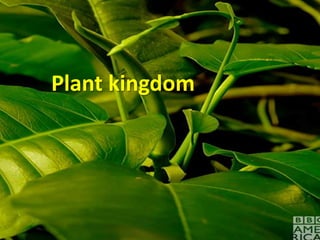
Plant kingdom and plant taxonamy
- 2. Kingdom Plantae further classified in to
- 3. Fungi, and members of the Monera and Protista having cell walls have now been excluded from Plantae.. • The cyanobacteria that are also referred to as blue green algae are not ‘algae’..
- 6. Artificial classification • The earliest systems of classification by Carolus Linnaeus.. • Based on morphological characters such as habit, colour, number and shape of leaves only etc. • They were based mainly on vegetative characters or on the androecium structure..
- 7. • Such systems were artificial; they separated the closely related species since they were based on a few characteristics. • Also, the artificial systems gave equal weightage to vegetative and sexual characteristics; this is not acceptable since we know that often the vegetative characters are more easily affected by environment
- 8. Natural classification systems by George Bentham and Joseph Dalton Hooker. • This classification not only the external features, but also internal features, • Ultrastructure (structure within a cell,).. • Anatomy • embryology • phytochemistry
- 9. Phylogenetic classification: • Based on evolutionary relationships between the various organisms. • This assumes that organisms belonging to the same taxa have a common ancestor. • Fossil are supporting evidence.
- 10. Numerical Taxonomy • Carried out using computers is based on all observable characteristics. • Number and codes are assigned to all the characters. • In this way each character is given equal importance and at the same time hundreds of characters can be considered.
- 11. • Cytotaxonomy: • based on cytological information like chromosome number, structure, behaviour. • Chemotaxonomy: • Chemotaxonomy uses the chemical constituents of the plant to resolve confusions, are also used by taxonomists these days..
- 12. • Chemotaxonomy uses the chemical constituents of the plant to resolve confusions, are also used by taxonomists these days.. Chemotaxonomy:
- 13. ALGAE • Algae are chlorophyll-bearing, simple, thalloid, autotrophic and largely aquatic (both fresh water and marine) organisms. • They occur in a variety of other habitats: moist stones, soils and wood.
- 14. Algae association • Some of them also occur in association with fungi (lichen). • animals (e.g., on sloth bear).
- 15. The form and size of algae is highly variable • Unicellular: Chlamydomonas, Chlorella, Spirullina. • Colonial: Volvox • Filamentous : Ulothrix and Spirogyra.
- 16. Kelps (marine): massive plant bodies.
- 17. The algae reproduce by vegetative, asexual and sexual methods. • Vegetative reproduction is by fragmentation. • Asexual reproduction is by the production of different types of spores, the most common being the zoospores. • zoospores. are flagellated (motile) and on germination gives rise to new plants
- 18. Sexual reproduction takes place through fusion of two gametes..
- 19. Sexual reproduction takes place through fusion of two gametes • Chlamydomonas: Gametes can be flagellated and similar in size. • Spirogyra: non-flagellated (non-motile) but similar in size • Such reproduction is called isogamous.
- 20. Anisogamous. • Fusion of two gametes dissimilar In size, as in some species of Chlamydomonas is termed as anisogamous.
- 21. Oogamous • Fusion between one large, non-motile (static) female gamete and a smaller, motile male gamete is termed oogamous.. • e.g., Volvox, Fucus.
- 22. Algae are useful to man in a variety of ways. • At least a half of the total carbon dioxide fixation on earth is carried out by algae through photosynthesis. • Algae increase the level of dissolved oxygen in their environment..
- 23. Primary producers of energy-rich compounds for aquatic animals • Many species of Porphyra, Laminaria and Sargassum are among the 70 species of marine algae used as food.
- 24. Certain marine brown and red algae produce large amounts of hydrocolloids (water holding substances), • algin (brown algae) • carrageen (red algae)
- 25. Agar-agar • Agar, one of the commercial products obtained from Gelidium and Gracilaria. • Used to grow microbes and in preparations of ice- creams and jellies..
- 26. Chlorella and Spirullina • Chlorella and Spirullina unicellular alga.. • Rich in proteins is used as food supplement even by space travellers.
- 27. The algae are divided into three main classes: • Chlorophyceae • Phaeophyceae • Rhodophyceae • The presence of pigments is the main basis of the classification of algae. • Based on storage food materials • Cell wall composition. • Thallus structure..
- 28. Chlorophyceae • Chlorophyceae are commonly called green algae. • The plant body may be unicellular, colonial or filamentous. • They are usually grass green due to the dominance of pigments chlorophyll a and b.
- 29. The pigments are localised in definite chloroplasts. • The chloroplasts may be • discoid, • plate-like, • reticulate, • cup-shaped • spiral • ribbon-shaped in different species
- 31. Storage bodies called pyrenoids located in the chloroplasts. • Pyrenoids contain protein besides starch. • Some algae may store food in the form of oil droplets. • Green algae usually have a rigid cell wall made of an inner layer of cellulose and an outer layer of pectose.
- 32. Pyrenoid • Each pyrenoid has a central protein and surrounding starch sheath.
- 33. Reproduction: • Vegetative reproduction usually takes place by fragmentation.. • Asexual reproduction is by flagellated zoospores produced in zoosporangia. • The sexual reproduction may be isogamous, anisogamous or oogamous..
- 34. Some commonly found green algae are: • Chlamydomonas, • Volvox, • Ulothrix, • Spirogyra • Chara
- 35. THANK YOU Dr. HarinathaReddy Aswartha Assistant professor Department of Microbiology ANDHRAPRADESH INDIA
